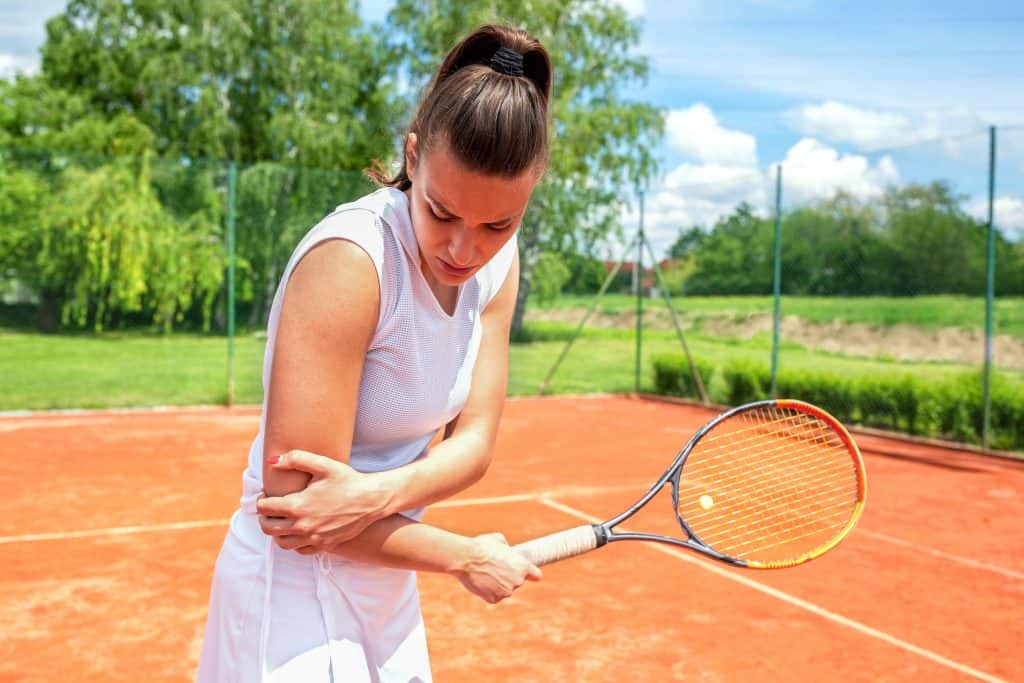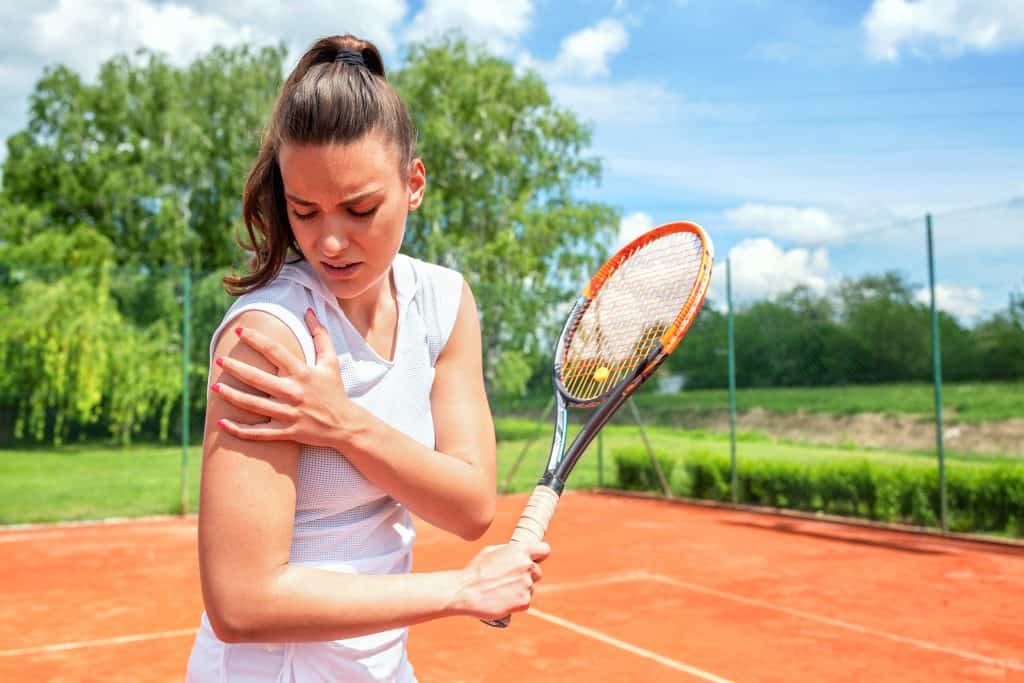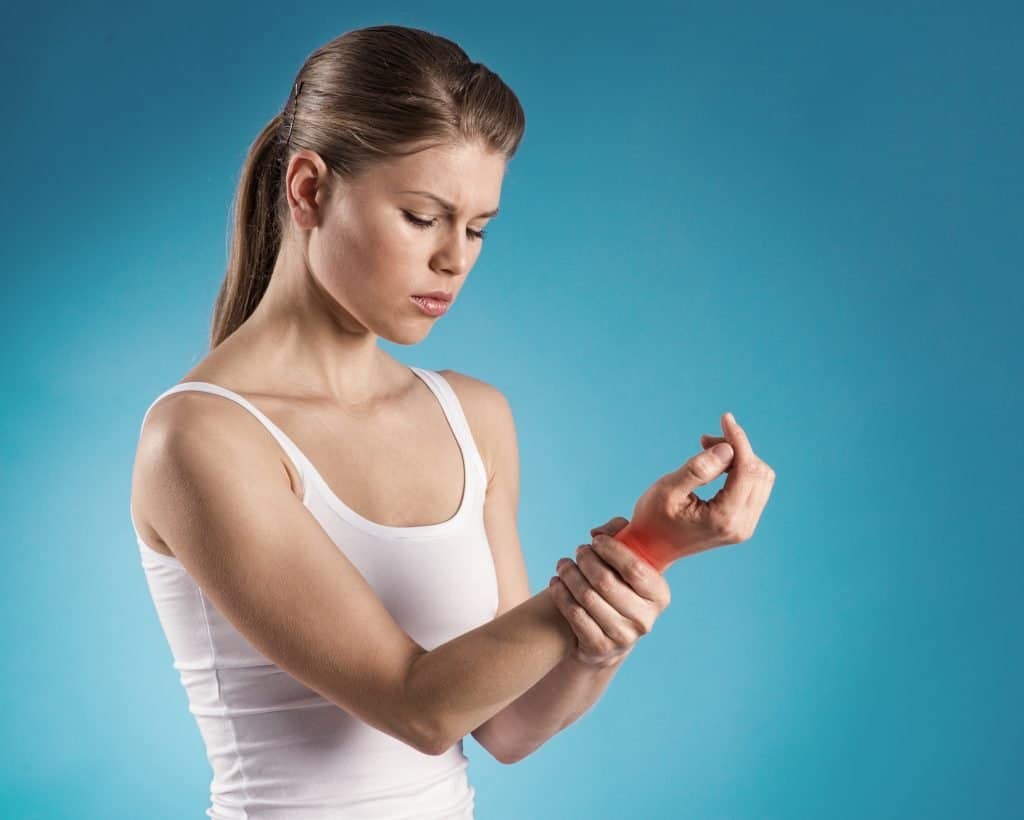Tennis is a great sport for so many different reasons. It requires a level of athleticism, yet so many people of all ages, genetics, and sexes play it. This is because it’s a sport that increases in fun and level of difficulty as you get better.
Seems weird to read that?
It’s not. Think about it. Strategy develops. Competition increases. You have more tools under your belt to place the ball where and when you want.
This is what makes the sport fun. The downside to this is that tennis can be quite a physical game at any level, and you really need to take care of your body to ensure you don’t come across these five common injuries.
But even in the best preventative care, tennis injuries happen. Check out these tips and tricks for preventing and managing tennis injuries.
Table of Contents
1. Tennis Elbow
One of the most common injuries in tennis is classically referred to as tennis elbow. Its official name is lateral epicondylitis and can even happen to someone when they don’t play tennis. The main reason anyone gets this chronic pain in their elbow is that overuse or bad form/technique.

Tennis elbow can be either:
- Inflammation
- Microtearing of the tendons
Information of the tendon and muscles that go from your fingers through your forearms and attach to your elbow is really common when the same repetitive motion occurs. This specifically applies to tennis because the wrist and fingers wrap around the racket tightly, causing the forearm to tense up. The more tennis you play and the tenser you hold your racket, the more prone you are to tennis elbow.
Micro tearing of the tendons that join the forearm to the elbow is another result of a painful tennis elbow. This is because this starts fibrosis and scar tissue build-up, making the joint stiff and unpleasant.
This can cause a limited range of motion and trouble bending and unbending the elbow. It is common to have this kind of soft tissue injury on your arm, that is it with the forehand. It is not to say that you can’t get it on your left arm if you are a righty, it is just more common to experience the pain on your dominant arm.
How To Treat/Prevent:
There are several solutions that you can do to prevent and treat tennis elbow. Some of these are natural ways to deal with it, and then there are assistance routes. Here are some of the steps you can take.
The R.I.C.E. method is a common injury prevention and current injury treatment option that can be really beneficial to someone who is prone to or is dealing with tennis elbow.
It stands for Rest, Ice, Compression, Elevation. The first thing anyone should do when experiencing current symptoms of tennis elbow is to rest it. Continuing to play when your elbow is experiencing aggravation will only make it worse and the recovery time longer.
Next, you should ice immediately. This goes for anyone who wants to do preventative care as well. Naturally, our joints and muscles become inflamed after working out. For intense hitting sessions and reduced soreness the next day, icing is always a great idea. It’s an absolute must for anyone who is already dealing with tennis elbow.
Compression is also both a great preventive and active recovery for tennis elbow. Compressing the area immediately after playing cuts of the inflammation from getting worse.
Elevate is the last step and is mainly a good idea for those already dealing with symptoms. This get’s the blood flow and healing process going.
Another natural option is to really stretch and warm up the muscle beforehand and after. This is both preventative care and active care. There are a few good stretches to keep in mind when dealing with tennis elbow. It’s important to mobilize the joint to break up the stiffness.
Try focusing the stretches on wrist mobility as well as forearm stretches to keep it from tightening up.
Graston Technique/Massage therapy is an assisted option where you can take certain tools and perform a massage technique to really break up the scar tissue. It can be very helpful later on but sometimes painful at the moment. This should be done by a licensed physical therapist.
2. Rotator Cuff Injuries
Those who play sports with overhead motions such as tennis, baseball, quarterbacks, etc., often deal with rotator cuff injuries. These are shoulder injuries that can be in the form of tears, sprains, or strains. It comes from wearing down the tendon over a period of time.

What happens is that the arm is kept in the shoulder through the socket by the rotator cuff. The rotator cuff is comprised of a group of muscles and tendons that attach to the humerus. The humerus is the long bone in our body. These muscles allow us to rotate and move our arms around easily, so once they experience strains, sprains, and tears, it can become quite painful.
Every time a player goes to serve and meets contact with the ball, they put a lot of stress on these muscles and can cause overtime wear and tear or an even acute injury for a hit gone wrong.
Often this injury may feel like a dull ache deep inside the shoulder if chronic. This is likely the people who are older and have repetitively used it. You may also experience difficulty or limited range of motion doing things overhead, like brushing your hair.
How To Treat/Prevent:
Rotator cuff injuries may not feel serious in certain circumstances but should be treated as such. Maria Sharapova is a great example who dealt with these kinds of shoulder injuries and eventually had to get surgery to avoid total loss of range of motion.
The best thing anyone can do who plays tennis is to work on preventative care regardless if they experience this injury or not. Constantly strengthening the shoulder muscles and working on flexibility is important. Therefore consider these exercises.
Shoulder Work With Resistance Bands
Warming up with resistance bands is like killing two birds with one stone. You get to properly warm your muscles up to avoid acute shoulder injuries, and you get to work on strengthening them.
Consider these exercises to help:
Massage
Getting a licensed therapist to massage the area can be beneficial. It is important to have someone who knows what they are doing because tears/sprains/strains can worsen with a massage. They can work the muscles around the injury to relieve pressure.
Those who are already dealing with these symptoms can use hot and cold compresses to reduce the swelling in the affected areas and keep the muscles and tendons from tightening up.
In situations where the rotator cuff is in a lot of pain, it is best to seek medical professionals’ help. There is a multitude of options, such as cortisone shots and surgeries that a doctor may suggest looking into for long-term health.
3. Wrist Injuries
Another common injury that happens to tennis players is problems with the wrist. This can be something like a fracture or ongoing arthritis. There is also a possibility for wrist strains and sprains as there are multiple tendons and muscles that work to move the wrist.

If you are a player who is already dealing with wrist pain, whether it be acute or chronic, it is important to seek a doctor’s opinion. This is because they can tell you if it is a strain or fracture and the level of severity.
The reason why wrist injuries can be common with tennis players falls under the same lines of repetitive use. This can be even more likely for those who hold extreme grips that put their wrists in stressful positions upon contact.
There are ways to treat and prevent injuries, and some are easier than others. Check this advice out on how to preserve your wrist best.
How To Treat/Prevent:
Some things really are easier than others. Wrists are the part of the body part that really can take a lot of impact from hitting the ball. They also are really flexible, which can be both a good thing and a bad thing cause of this instability.
The most difficult thing for anyone to do is to ensure they have good technique. For those just starting out, this is an easy thing to correct. However, for those who may be experiencing wrist pain, it is likely you have already been playing quite some time. It is worth the investment to change grips from more extreme handles to more wrist-protecting positions.
Naturally, even those with good grip and technique may experience wrist pain. For those who have chronic wrist pain, an antiinflammatory medicine combined with the R.I.C.E. method mentioned above will be both preventative and active care for wrist issues.
Strengthening the wrist and keeping flexibility and mobility is also another great active and preventative measure that anyone can take.
A third alternative that falls both under preventive and active care again would be taping your wrists. At first, this may seem uncomfortable. However, have you ever noticed a heavy-weight lifter who goes to benchpress has wrist supports? This is the same function for tennis. It can really keep your wrist supported and inline.
4. Back Injuries
Tennis is a sport with a lot of rotation on every single shot that is hit. The power comes from getting toque. This can cause chronic or acute back muscles if certain steps are taken to properly care for your body as you play tennis.
Muscle tears and constant aching is not unfamiliar to the tennis world. Often times back pain can come from not warming up properly and age. As the muscles get used more and more, they need to be strengthened and allowed the appropriate recovery time to perform in a strong state.

Common back injuries include herniated discs from rotation, facet joint pain, sciatica, stress fractures, etc.
Any injury really should be met with a medical expert’s advice, but any tingling and numbness in the back is a sign of an issue, and that player should immediately seek professional help.
How To Treat/Prevent:
For the more common aches and pains that come with tennis and lower back pain, there are a number of things you can do to help prevent more serious injuries. Some of these techniques are repetitive like massage therapy. However, there are a number of other things you can do.
Ice baths are like R.I.C.E but a much easier way of reaching all of the back and reducing inflammation. This may be unpleasant but really has great benefits for those needing to reduce next-day soreness to perform again.
Yoga/Stretching is also a great way to keep the back loose and flexible A proper warm-up is a given and good stretch, but constantly working on the back’s flexibility and strengthening the muscles through alternative exercises like yoga is a great idea.
Foam rollers are also a great way to loosen up the back before practice and a great way to get the lactic acid out after practice. Foam rollers are a small investment into a back massage that can produce wonderful effects and prevent back injury.
5. Knee Injuries
Last but certainly not least are knee injuries. Knee injuries are last because they are a little bit more tricky than the rest of the group. Knee injuries are very common among tennis players because of all the cutting and starting/stopping from footwork. This ultimately wears at the knee and can cause similar injuries to tennis elbow in the knee or more acute and serious injuries like ACL tears.

Knee health is a really important thing as it can be career-ending, so preventive care is a must for everyone. For those who already have a more serious knee injury, chances are you have seen the doctor and are on a plan.
For those with chronic knee pain, it’s still not a bad idea to see a doctor, but R.I.C.E is always recommended.
How To Treat/Prevent:
There are a few things you can do to prevent knee injuries.
First and very easy to understand is warming up properly for any kind of tennis exercise. This means getting a sweat going and doing proper leg stretches.
More specifically, in the gym, you can strengthen the quadriceps and the other leg muscles to provide support to the knee. When the leg muscles are weak, the knee can endure too much stress and eventually get injures.
Making sure you have the right shoes, and if needed, orthotics are really important. Sometimes, we may have a certain instep or misalignment that orthotics or certain shoes can fix. When we don’t fix this, it’s possible that the knee is bearing too much pressure or weight.
Conclusion
Most tennis injuries can be prevented with the right preventative and active care. If you aren’t sure what to do, your two best options are seeking professional medical help and going back to the basic R.I.C.E. Most injuries can be associated with overuse and swelling if chronic. That is where R.I.C.E. will come in handy.
More immediate and acute injuries should always be talked over with a doctor if serious. This may require more assistance in the healing process than what you have access to at home.